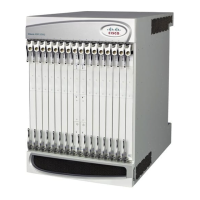▀ NSP-ID and NAP-ID Functionality
▄ Cisco ASR 5000 Series Product Overview
NSP-ID and NAP-ID Functionality
NSP-ID and NAP-ID functionality enable the MS to discover all accessible network service providers (NSPs) in a
WiMAX coverage area, and to indicate the NSP selection during connectivity to the ASN. The actual NSP selection by
the MS may be based on various preference criteria, depending on the configuration information.
Configuration information includes:
Information useful in the MS discovery of the network access provider (NAP), including channel center
frequency and PHY profile,
Information useful in the MS decision mechanism to prioritize NSPs for automatic service selection, including a
list of authorized NAPs and NSPs,
A list of authorized share or roaming relationships between authorized NAPs and NSPs and partner NAPs and
NSPs,
Identity credentials provided by the NSPs to which the MS has a business relationship, and
The mapping relation table between 24-bit NSP identities and corresponding realms of the NSPs.
Configuration information may be provided on a pre-provisioned basis or at the time of MS dynamic service
subscription.
Manual Mode
The NSP Enumeration List is presented to the user for selection. Each entry presents only the verbose NSP name to the
user. If more than one NAP can be used to establish a direct connection with a NSP, the MS may indicate each of the
candidate NAPs along with the NSP or verbose NSP name to the user in the following order:
Home NSP.
If the ―User Controlled RAPL‖ (Roaming Contractual Agreements Preference List) is available, NSPs or their
corresponding verbose NSP names in the ―User Controlled RAPL‖ in the MS (in priority order),
If the ―Operator Controlled RAPL‖ is available, NSPs or their corresponding verbose NSP names in the
―Operator Controlled RAPL‖ in the MS (in priority order),
Any other NSP or their corresponding verbose NSP names in random order.
Upon selection and successful authentication to the selected NSP, the MS indicates the selected NSP. If no NSP is
found, the MS behavior is implementation dependent.
Automatic Mode
For Automatic Mode, without user intervention, the MS selects a NAP that has a direct connection to the home NSP. If
more than one NAP can be used to establish a direct connection with an NSP, the MS selects a NAP by using ―User
Controlled CAPL‖ (Contractual Agreements Preference List) or ―Operator Controlled CAPL‖.

